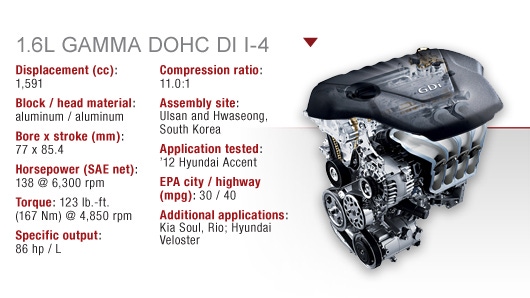Hyundai 1.6L DOHC DI I-4Hyundai 1.6L DOHC DI I-4
The 1.6L GDI Gamma 4-cyl. in the Hyundai Accent stands out like welterweight champion Manny Pacquiao in a room full of club fighters when it comes to power, advanced technology and efficiency.
January 6, 2012

High-pressure gasoline direct injection is a key new technology sweeping the industry that enables engines to increase power and reduce emissions. Yet some auto makers have been slow to implement GDI, claiming it still is too expensive for mainstream vehicles.
Hyundai is offering GDI on the Accent subcompact, which starts at $12,445.
The 1.6L GDI Gamma 4-cyl. in the Accent did not stun us with head-snapping acceleration or seduce us with a sonorous exhaust note, but in the entry-level segment, thanks to GDI, it stands out like welterweight champion Manny Pacquiao in a room full of club fighters when it comes to power, advanced technology and efficiency.
The small engine blows away its naturally aspirated competition with a specific output of 86.3 hp/L and 123 lb.-ft (167 Nm) of torque. It also has a notable list of technical features not usually found in this class, including dual continuously variable valve timing, electronic throttle control, a roller timing chain and several types of sophisticated anti-friction coatings on moving parts such as valvetrain tappets and piston rings.
Using CVVT on both camshafts (intake and exhaust camshaft phaser) instead of one improves performance and volumetric efficiency as well as enhancing fuel economy and reducing hydrocarbon emissions.
The roller timing chain increases reliability while the electronic throttle controls air intake and engine torque more precisely, which translates into better throttle response and higher mileage.
That’s not to say Hyundai is the only auto maker offering advanced technology in this year’s crop of econocar four bangers.
The port-injected 1.6L DOHC I-4 in the Nissan Versa SL sedan touts an innovative fuel-delivery system that uses two injectors mounted near the inlet valve of each cylinder. The system reduces the amount of unburned fuel and hydrocarbon emissions in the exhaust stream. This efficiency allows Nissan to halve the amount of expensive rare metals required in the catalyst.
But the meager 109 hp of the Nissan engine caused editors to ultimately favor the Gamma in the Accent, where it really shines.
In another impressive move, Kia, which shares the Gamma engine with Hyundai, adds a stop/start system on the engine for the Kia Soul and Rio cars.
Editors raved about the Gamma’s precise and lively throttle and the air of sophistication it lends to the Accent, one of the lowest-priced cars in the U.S. “It’s an entry-level engine with a lot of integrity,” says WardsAuto editor Steve Finlay.
“I loved this engine. It’s a lot for a little money,” says WardsAuto editor Jim Irwin.
We were not successful reaching the fuel efficiency levels touted by auto makers on the stickers of most of our test vehicles, but we came close with the Accent. One judge observed 38.5 mpg (6.1 L/100 km) during a combined city/highway test drive, just shy of the 40 mpg (5.9 L/100 km) highway figure it advertises.
But even though we all thoroughly enjoyed the normally aspirated engine in the Accent, WardsAuto editor Tom Murphy says out loud what we all are thinking: “I can’t wait for the turbo version.”
Read more about:
2012 10 Best EnginesYou May Also Like